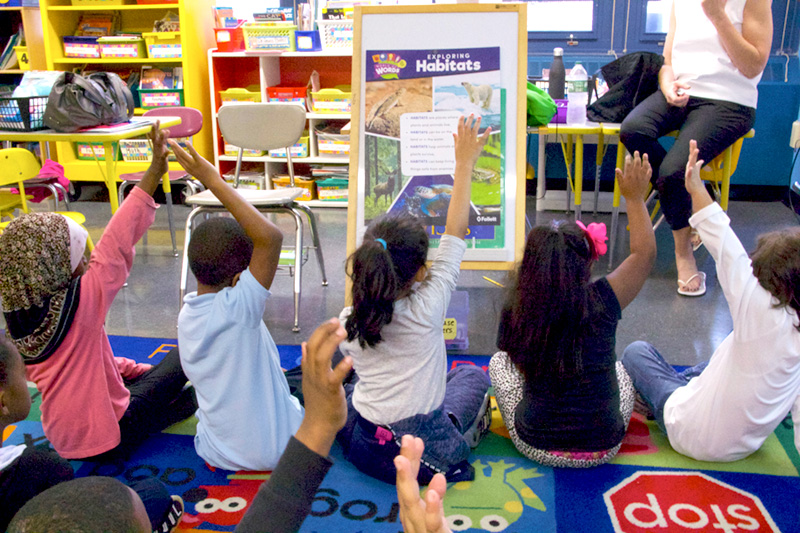Though it’s been decades since I’ve read it, I’m certain I could come out of a deep sleep and, if commanded, recite The Cat in the Hat in its entirety. From “The sun did not shine…” to “What would YOU do if your mother asked you?” with individual voices for each character, I could tell that story. Thanks to what felt like hundreds of hours of repetition for both of my kids, Dr. Seuss’s classic is engraved on my heart.
And that’s a good thing, says Dr. Susan B. Neuman, professor of childhood and early literacy at New York University, even if a parent or caregiver feels as though they might crack if they read their toddler Brown Bear, Brown Bear, What Do You See?* one more time. Repetition is one of the elements that help connect children not only with words but with the world those words create.
Neuman has researched and written extensively on literacy learning for young children. Her paper for the journal Contemporary Educational Psychology, “Developing Low-income Children’s Vocabulary and Content Knowledge Through a Shared Book Reading Program,” examines an intervention designed to improve low-income children’s vocabulary and knowledge in science.
In choosing books for the study, Neuman says, one of the criteria was the book’s “repeatability.”
“We wanted short reads,” Neuman says, “ones where the child could say, ‘Oh, that was so much fun. Read it to me again!’ And that’s when you say to yourself, ‘All right. I’ve made it.’”
The year-long study involved pre-K through first grade classrooms in 12 elementary schools with from 71% to 100% free-and-reduced lunches (a community poverty measurement) in a large metropolitan area. Classrooms were randomly selected to participate in a supplemental program in which the children were read aloud to about science topics. The control classrooms simply offered the usual curriculum; the study’s total sample included 24 intervention classrooms and 21 control classrooms. Before classes began, pre-K and kindergarten teachers for the intervention classrooms participated in a day of training to review the texts to be used and examine how the topics built on one another to establish big ideas in science. Teachers in each school were assigned a coach responsible for supporting the intervention throughout the year.
The results were noteworthy: Children in the read-aloud group learned significantly more words and science concepts than those in the control groups, with growth for English language learners (ELL) exceeding that of native speakers.
More than Words
Closing the literacy gap has long been a passion for Neuman, who helped bring public attention to the fact that book deserts exist in the U.S. in which there are virtually no books for children living in poverty. Indeed, poverty is one of the most powerful determinants of whether a child is ready to learn to read at the “starting gate” of preschool and kindergarten. In the late 1990s, acknowledging the “word gap” experienced by children in poverty helped spur interest in foundational skills such as print concepts (for instance, that we read from left to right in English), word recognition and phonics, Neuman says. But even recognizing and addressing the word gap fails to tell the whole story. Before they reach kindergarten, the average cognitive score of children in the nation’s highest socioeconomic group is 60% above the score of children in the lowest-income group—an even deeper problem for children who are non-native English speakers, who now represent nearly one in five U.S. students.

Learning to read and acquire knowledge is a cumulative process. As children begin to grow their vocabulary and gain conceptually rich knowledge, they’re then able to learn at a faster rate, a snowball effect that enables them to keep deepening their understanding of the world. So, while the focus on teaching children fundamentals and phonics was important, Neuman said she and her team were concerned by how little interest there seemed to be in vocabulary-building and seeing to it that children developed the background knowledge so central for comprehension.
“(For a long time) there was the notion that children should just learn words without them being connected to knowledge,” she says. “Even when I went to school, we would have this list of words to learn, and we’d have to look up their definition in a dictionary. But we never knew exactly why we were doing this.
“Why should a child learn to read? Why would they want to do this?”
One very good answer to that question? Science!
“Our study focused on science for a number of reasons,” Neuman says. “Children are fascinated with their world. They’re interested in their environment; they’re fascinated with such common things as the weather. Worms are interesting. Animals are interesting. Everything is new.
“Math is important, but to a young child, it isn’t as intriguing as science. Also, science is very structured as a domain, so you can use it to develop concepts. When you develop concepts, you begin to cluster ideas together and children begin to make inferences,” Neuman explains.

She adds, “For example, a child might learn that insects have six legs and three body parts. Is a moth an insect, then? Yes. Well, what about a spider? Well, no, because spiders have eight legs. The child begins to understand similarities and differences, which form concepts that provide them with the rich knowledge base that allows them to fill in those semantic gaps where the meaning may not be crystal clear, but you fill in the blanks. That’s how children begin comprehending.”
From concepts like, “Bugs have six legs,” the conversation expands to domains, such as “Bugs are living things; lions are living things. What do living things need?” That discussion leads to big ideas that crosscut the concepts, such as all living things needing food, water and air. And from there, it isn’t long until you’re talking with a bunch of kindergartners about habitats.
“What you see them doing is building a schema, or a knowledge network that allows them to remember those concepts and recall them when they’re needed,” she says. “When they learn about survival, for instance, and they read in different genres, they have that knowledge of vocabulary that becomes deeper and deeper over time.”
Reading Aloud
The researchers set up the study as a read-aloud program because studies have shown that this is one of the most important vehicles for developing rich vocabularies and content knowledge. Before the children can read on their own, a teacher or parent reading to them introduces the idea that those squiggles on the page are words, those images are connected to the squiggles, and they can learn to read those squiggles, too.
“Nothing else is quite as powerful as the read-aloud experience,” Neuman says. “What we know is that very often when parents read to a child, they’re not just reading the book, they’re talking about things related to the book—how they’re living, what they’ve done. For instance, a parent might say, ‘Do you remember when we did this?’ The book will recall events and histories between the parent and child, which becomes so powerful for them.
“And when a child is looking at a book and asking questions, the parent responds, and the questions keep coming. So, parents need to be responsive to children’s queries.”
Those questions and answers create our old friend, conversational turns, the back-and-forth mechanism that adults use to extend children’s language.
It’s also important, Neuman says, to call it quits when the book isn’t working for the child. Nobody wants bedtime book-reading to be like soldiering through a bad book-club selection.
The Right Book
The researchers used specific criteria to select books for the program, Neuman says.
- The books had simple text, with beautiful, simple pictures that represented the diversity of the children they were working with.
- The books were “predictable,” meaning they had repeated lines that would encourage the children to chime in and would encourage the reader to solicit the child’s response, “What do you see?”
- The illustrations were clear. Neuman says even many pre-K books that may have only a few main words often have confusing illustrations. Clear illustrations with bold colors are best because children love bold colors and will pay attention to them.
- Keep it simple and short. “A lot of times, parents make a mistake by selecting something a bit too complicated for children,” she says. “They’ll look and see that it’s a picture book. But you need to look inside and if there’s too much detail or too many words, maybe pass on that one. I’d rather read, repeat and read the story again than have a too-complicated book that loses the child’s interest.”
Nonfiction for the Win
Though some adults may think children need storybooks with cute animals and characters to pique their interest, Neuman says the research shows that they’re equally interested in informational, nonfiction or narrative nonfiction texts.
“We just did an eye-tracking study where we were looking at children’s attention as they’re being read to,” she says. “It’s very clear from our study that they like informational text just as much as storybooks and their attention was high with both genres. Yet, they remembered more, and the learning was stronger from the informational text. So, I encourage parents and teachers to think about that.”
The bottom line, Neuman says, is that children need both word and world (content knowledge) to learn to read and understand complex texts in later grades. Starting early is crucial, and children learn to understand words when they hear them frequently over time and in multiple domains.
So go ahead; start from the top. And again.
Brown Bear, Brown Bear, what do you see …
Contemporary Educational Psychology Developing Low-Income Children’s Vocabulary and Content Knowledge through a Shared Book Reading Program Authors Susan B. Neuman and Tanya Kaefer
*Brown Bear, Brown Bear, What Do You See? By Bill Martin Jr. and Eric Carle 1996, published by Priddy Books US

K.C. Compton
K.C. Compton worked as a reporter, editor and columnist for newspapers throughout the Rocky Mountain region for 20 years before moving to the Kansas City area as an editor for Mother Earth News. She has been in Seattle since 2016, enjoying life as a freelance and contract writer and editor.


